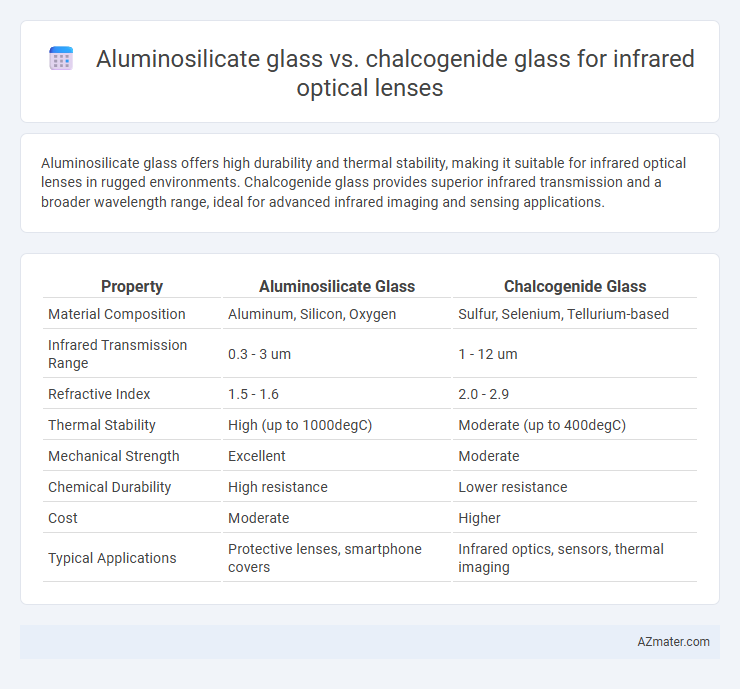Aluminosilicate glass offers high durability and thermal stability, making it suitable for infrared optical lenses in rugged environments. Chalcogenide glass provides superior infrared transmission and a broader wavelength range, ideal for advanced infrared imaging and sensing applications.
Table of Comparison
| Property | Aluminosilicate Glass | Chalcogenide Glass |
|---|---|---|
| Material Composition | Aluminum, Silicon, Oxygen | Sulfur, Selenium, Tellurium-based |
| Infrared Transmission Range | 0.3 - 3 um | 1 - 12 um |
| Refractive Index | 1.5 - 1.6 | 2.0 - 2.9 |
| Thermal Stability | High (up to 1000degC) | Moderate (up to 400degC) |
| Mechanical Strength | Excellent | Moderate |
| Chemical Durability | High resistance | Lower resistance |
| Cost | Moderate | Higher |
| Typical Applications | Protective lenses, smartphone covers | Infrared optics, sensors, thermal imaging |
Introduction to Infrared Optical Lenses
Infrared optical lenses require materials with specific transmission ranges and refractive indices to efficiently focus infrared light. Aluminosilicate glass exhibits high mechanical strength and good thermal stability but has limited transmission in the mid-infrared range. Chalcogenide glass offers superior infrared transmission from 1 to 14 microns and a high refractive index, making it ideal for mid- to long-wave infrared optical applications.
Overview of Aluminosilicate Glass
Aluminosilicate glass offers superior thermal and chemical durability compared to chalcogenide glass, making it ideal for infrared optical lenses in harsh environments. Its high melting point and excellent mechanical strength enable precise fabrication and long-term stability in mid-infrared applications. The material's transparency range typically spans from 0.3 to 4 microns, providing effective performance for near to mid-infrared imaging systems.
Overview of Chalcogenide Glass
Chalcogenide glass consists primarily of chalcogen elements such as sulfur, selenium, and tellurium combined with other elements like arsenic and antimony, offering broad infrared transparency from 2 to 12 microns. Compared to aluminosilicate glass, chalcogenide glass provides superior infrared transmission and higher refractive indices, making it ideal for infrared optical lenses used in thermal imaging and spectroscopy applications. Its unique properties include low phonon energy and high nonlinear optical response, enabling enhanced performance in mid- to long-wavelength IR systems.
Infrared Transmission Range Comparison
Aluminosilicate glass typically offers an infrared transmission range from about 0.35 to 2.5 microns, making it suitable for near-infrared applications but limited in mid-infrared performance. Chalcogenide glass provides a broader infrared transmission range, often extending from 1 to 12 microns, which covers key mid- to far-infrared wavelengths essential for thermal imaging and sensing technologies. This significant difference in IR transmission ranges positions chalcogenide glass as the preferred choice for advanced infrared optical lenses requiring wide-spectrum sensitivity.
Thermal and Mechanical Properties
Aluminosilicate glass exhibits high thermal stability with a low coefficient of thermal expansion, making it resistant to thermal shock and suitable for harsh environments in infrared optical lenses. In contrast, chalcogenide glass offers lower thermal conductivity and higher softness, resulting in reduced mechanical durability and increased susceptibility to deformation under stress. The robust mechanical strength and enhanced hardness of aluminosilicate glass provide superior long-term performance compared to the relatively fragile chalcogenide glass in IR optical applications.
Optical Performance Considerations
Aluminosilicate glass offers high durability and excellent transmission in the near-infrared (NIR) range, making it suitable for applications requiring mechanical strength alongside good optical clarity. Chalcogenide glass provides superior transmission in the mid to far-infrared (mid-IR to far-IR) spectrum with lower absorption losses and a higher refractive index, enabling enhanced sensitivity and resolution in thermal imaging and spectroscopy. Optical performance considerations prioritize chalcogenide glass for broadband IR applications due to its wide transmission window and tunable refractive properties, while aluminosilicate glass is preferred for environments demanding robustness and lower cost in NIR ranges.
Environmental and Chemical Durability
Aluminosilicate glass exhibits superior environmental and chemical durability compared to chalcogenide glass, resisting moisture, acids, and temperature fluctuations more effectively. Chalcogenide glass, while excellent for mid- to far-infrared transmission, is more susceptible to oxidation and chemical degradation under harsh environmental conditions. The robust aluminosilicate composition ensures longer lifespan and reliability for infrared optical lenses in demanding industrial and outdoor applications.
Cost and Manufacturing Differences
Aluminosilicate glass offers lower manufacturing costs due to established production processes and abundant raw materials, making it economically favorable for infrared optical lenses. Chalcogenide glass, while providing superior infrared transmission and flexibility in lens design, involves higher costs attributable to complex synthesis and purification methods. The durability and thermal stability of aluminosilicate glass allow for more straightforward fabrication and cost-effective large-scale production compared to the specialized handling required for chalcogenide materials.
Application Suitability in Infrared Optics
Aluminosilicate glass offers excellent mechanical strength and thermal stability, making it highly suitable for infrared optical lenses in harsh environments such as aerospace and defense applications. Chalcogenide glass, with its superior infrared transmission range from 2 to 12 microns, is preferred for thermal imaging, spectroscopy, and fiber optics in the mid- to long-wave infrared spectrum. The choice between aluminosilicate and chalcogenide glass depends primarily on the application's required wavelength range and environmental durability, with chalcogenide glass favored for broad IR transmission and aluminosilicate glass prioritized for robust physical properties.
Summary and Selection Guidelines
Aluminosilicate glass offers high mechanical strength and thermal stability with moderate infrared transmission, making it suitable for harsh environments and applications requiring durability. Chalcogenide glass provides superior infrared transparency across a broader mid- to far-infrared spectrum but is more sensitive to environmental degradation and mechanical stress. Select aluminosilicate glass for rugged, durable infrared lenses and chalcogenide glass when maximum infrared transmission and spectral range are critical, balancing performance with environmental conditions and cost.

Infographic: Aluminosilicate glass vs Chalcogenide glass for Infrared optical lens
 azmater.com
azmater.com